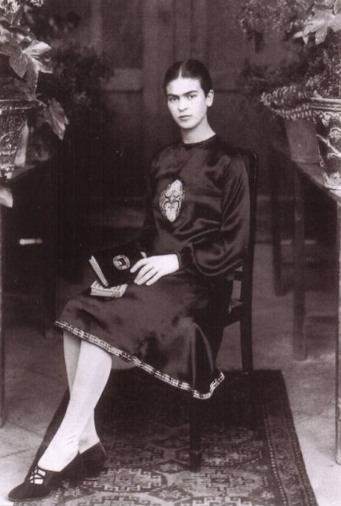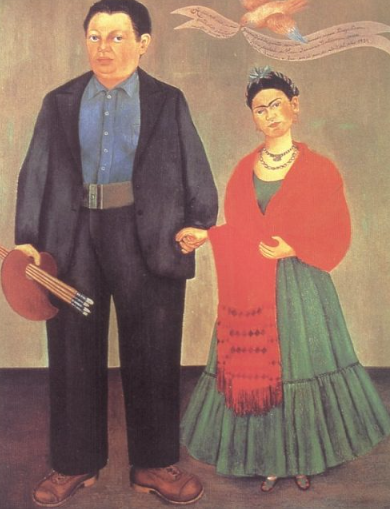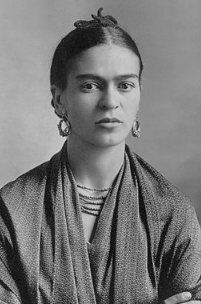TOP 10 Interesting Facts About Frida Kahlo
- 1. German Roots
- 2. Battling Numerous Illnesses
- 3. The Art of Depicting Suffering
- 4. A Messy Marriage
- 5. Sister's Affair with Her Husband
- 6. In Another's Arms: Frida's Love
- 7. Frida Kahlo as a Fashion Icon
- 8. A Large Number of Self-Portraits
- 9. Interpreting Portraits: Layers of Meaning
- 10. Favored by the Surrealists
Frida Kahlo's worldwide famous paintings, characterized by their vivid colors, surreal imagery, and intimate self-portraits, offer a profound glimpse into the complexities of her personal life and Mexican cultural identity, resonating with audiences and inviting exploration into her fascinating life and artistry to uncover intriguing facts about her. Are you familiar with these 10 Facts About Frida Kahlo? If not, be sure to read them to have something to discuss with friends!
1. German Roots

Frida Kahlo's
Born Magdalena Carmen Frieda Kahlo y Calderón, Frida Kahlo's name "Frieda" originates from the German word "Friede," which means "peace." It's said that she later dropped the "e" from her name around 1935, adopting the name Frida, a change that became synonymous with her artistic identity and persona.
2. Battling Numerous Illnesses

Young Frida Kahlo
Frida Kahlo endured a lifetime of debilitating health challenges, stemming from a devastating bus accident at the age of 18 that left her with severe injuries. Throughout her life, she suffered from chronic pain, spinal problems, and numerous surgeries. Additionally, at the age of 6, Kahlo battled polio and later faced complications from infections and gangrene. Frida underwent approximately 35 operations throughout her life! Despite her physical ailments, Kahlo channeled her pain and suffering into her artwork, using her self-portraits as a means of expressing her inner turmoil and resilience in the face of adversity. Her paintings often depicted her physical and emotional struggles, offering viewers a raw and intimate glimpse into her world of pain and perseverance.
3. The Art of Depicting Suffering

Frida Kahlo, The Art Of Depicting Suffering
Kahlo's art became an outlet for her anguish, with many of her paintings serving as poignant reflections of her own physical and emotional pain. Perhaps most hauntingly, her masterpiece "The Broken Column" (1944) stands as a testament to her enduring suffering, depicting Kahlo's shattered body pierced by nails, symbolizing the relentless agony she experienced throughout her life. Her ability to channel her suffering into her paintings is a testament to her inner strength and determination, showcasing her unwavering commitment to her artistic vision.
4. A Messy Marriage

Diego Et Frida, 1931
Frida Kahlo's marriage to fellow artist Diego Rivera was marked by tumultuous ups and downs, characterized by passionate love, intense conflicts, and frequent separations. Despite their deep affection for each other, their relationship was often marred by infidelities, jealousy, and emotional turmoil. Both Kahlo and Rivera had extramarital affairs, further complicating their already messy marriage. However, amidst the chaos, their bond endured, fueled by a shared dedication to art and a profound understanding of each other's creative endeavors. Despite their messy marriage, Kahlo and Rivera's union remains one of the most captivating and enduring love stories in art history.
5. Sister's Affair with Her Husband

Frida Et Cristina
The relationship between Diego and Frida Kahlo was turbulent, to put it mildly. Frida's world was shattered when she discovered her sister's affair with her husband, Diego Rivera. Despite the betrayal, Kahlo remained resilient, channeling her pain into her artwork. What is more, she made efforts to reconcile with Rivera, reflecting her deep emotional investment in their relationship. Through her paintings, she expressed her anguish and emerged as a symbol of strength and empowerment in the face of adversity.
6. In Another's Arms: Frida's Love

Frida Kahlo's relationship with Diego Rivera was marked by infidelity on both sides, with Kahlo engaging in a well-known affair with Leon Trotsky, the renowned Marxist revolutionary. This liaison added further complexity to Kahlo and Rivera's tumultuous marriage, highlighting the complexities and contradictions within their relationship dynamic. Despite their extramarital affairs, Kahlo and Rivera's bond endured, fueled by their shared passion for art and their ability to navigate the complexities of love and betrayal.
7. Frida Kahlo as a Fashion Icon

Self-portrait Dedicated To Dr. Eloesser, 1940
Frida Kahlo's physical pain contributed to her ongoing insecurities and torment. To confront her lack of self-assurance and feelings of displacement, she crafted multiple personas, both in her daily life and within her paintings. Known for her unusual appearance, Kahlo often adorned herself in opulent traditional Mexican attire, meticulously styling her hair and makeup as a means of navigating her inner turmoil and asserting her identity amidst adversity.
8. A Large Number of Self-Portraits

Frida Kahlo, The Broken Column, 1944
Frida Kahlo created a total of 55 self-portraits throughout her life. As for her total number of paintings, she produced approximately 143 works. Kahlo's first self-portrait was Self-Portrait in a "Velvet Dress" in 1926. One of her most famous self-portraits is Self-Portrait with Thorn Necklace and Hummingbird (1940). It draws on many of the references that characterize her work. In it, Frida stares stoically out despite the pain. The final piece she created was also a self-portrait. The terrifying picture "Frida in Flames" (1954) has a strong intensity.
9. Interpreting Portraits: Layers of Meaning

Frida Kahlo, Self-portrait With Monkey, 1938
Frida Kahlo's portraits are rich with layers of symbolism and significance, each capturing multiple meanings. Self-portrait with Monkey" by Frida Kahlo is another compelling example of this. In this artwork, Kahlo is depicted sitting alongside a small spider monkey, which is often interpreted as a representation of companionship and loyalty. However, the presence of the monkey can also symbolize the artist's inner turmoil and sense of isolation. Additionally, the lush vegetation and vibrant colors in the background evoke themes of fertility and growth, contrasting with the somber expression on Kahlo's face. Overall, the painting invites viewers to contemplate the complex interplay of emotions and symbols within Kahlo's self-portraits.
10. Favored by the Surrealists

Frida Kahlo
While Frida Kahlo was not officially associated with the Surrealist movement, she was indeed admired and supported by many Surrealist artists, including André Breton and Marcel Duchamp. They appreciated her unique artistic style, which often incorporated elements of dreamlike imagery, symbolism, and vivid imagination. Kahlo's work resonated with Surrealists due to its deeply personal and emotive nature, as well as its exploration of the subconscious mind. Though Kahlo herself did not identify as a Surrealist, she did exhibit her work alongside Surrealist artists and was influenced by Surrealist ideas to some extent. André Breton, the founder of Surrealism, described Kahlo's art as "a ribbon around a bomb," acknowledging its power to evoke raw emotion and challenge conventional artistic norms.
Overall, Frida Kahlo's association with the Surrealists underscores her status as a groundbreaking artist whose work transcended traditional boundaries and continues to inspire audiences worldwide.
How many facts out of 10 did you already know?
No Comments Yet...